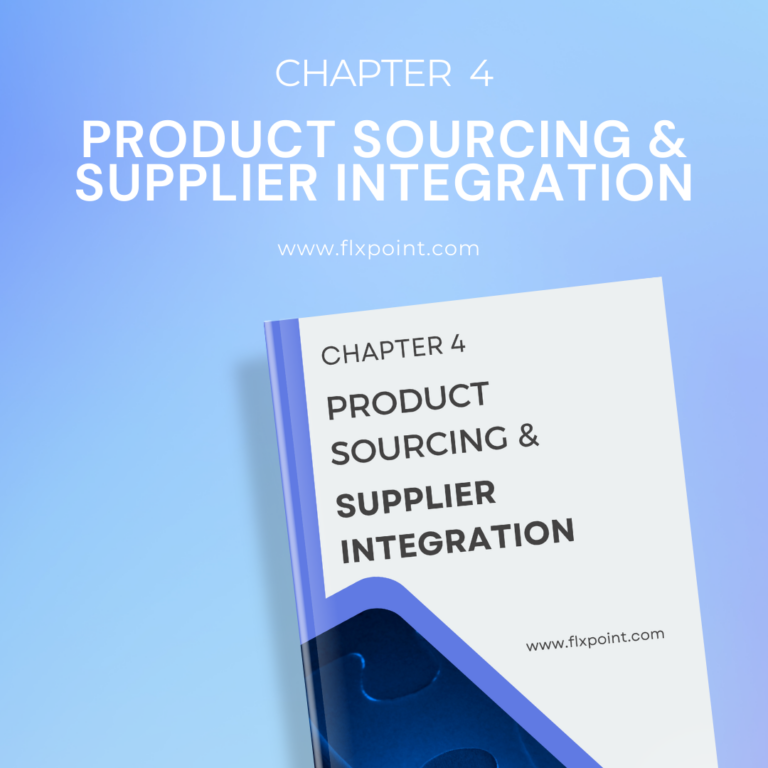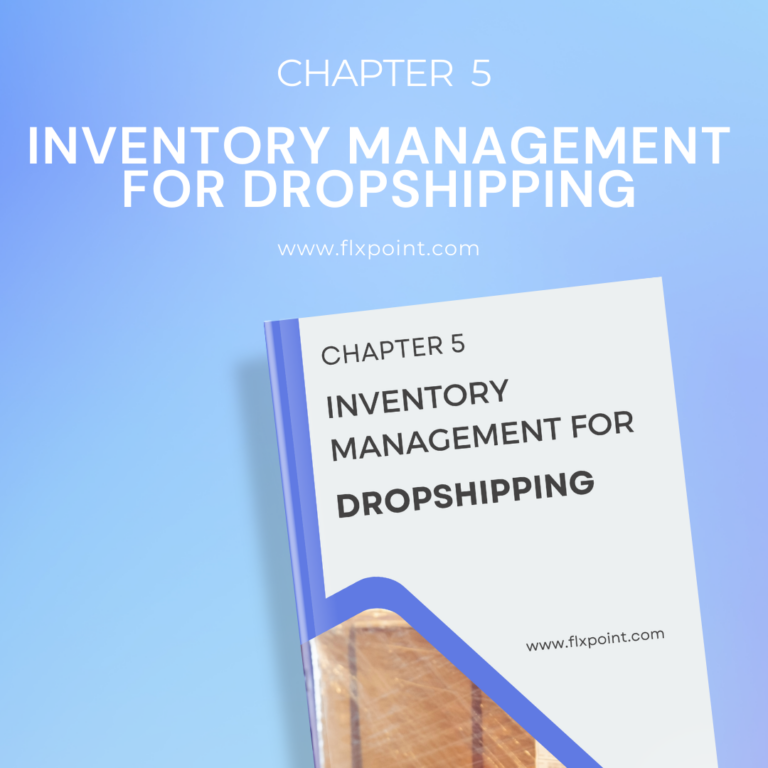Chapter 15 Troubleshooting Dropshipping Challenges with Advanced Tools
Gain insights into solving common dropshipping issues with advanced tools. Learn to handle inventory shortages, supplier delays, and customer service demands effectively.

Guide to Troubleshooting Dropshipping Challenges with Advanced Tools
Dropshipping challenges can significantly impact a business’s success. Common issues include inventory discrepancies, which can lead to fulfilling the wrong orders, and supplier delays that affect delivery times. Customer issues, such as returns or complaints, also arise when expectations are not met. These challenges can harm customer trust and satisfaction, leading to lost sales.
Addressing these challenges is vital for maintaining a smooth operation and ensuring long-term growth. Utilizing advanced tools like Flxpoint problem-solving capabilities can help streamline processes. By automating communication and providing real-time updates, Flxpoint enables businesses to respond quickly to issues. This proactive approach reduces errors and enhances the overall customer experience, making it essential for any dropshipping business aiming for success.
Common Dropshipping Challenges
Inventory Discrepancies
Inventory discrepancies are a frequent problem in dropshipping. They occur when the stock levels reported by suppliers do not match the actual inventory available. This mismatch can happen for various reasons, such as delays in updating inventory counts or inaccurate data entries by suppliers. Additionally, when multiple suppliers are involved, tracking inventory becomes more complex. Without effective systems in place, these errors can easily arise, leading to significant issues for dropshipping businesses.
Impact on Order Fulfillment And Customer Satisfaction.
- Order Delays – When an item is out of stock but still listed as available, it can lead to delays in fulfilling orders. Customers may have to wait longer than expected for their products.
- Canceled Orders – If a product cannot be fulfilled due to incorrect inventory levels, orders may need to be canceled. This can frustrate customers and damage the retailer’s reputation.
- Negative Reviews – Customers who experience issues with their orders are more likely to leave negative feedback, impacting future sales.
Supplier Delays
Supplier delays are a significant concern in the dropshipping model. They can occur for various reasons. First, suppliers may face production issues, such as machinery breakdowns or labor shortages. Seasonal demand spikes can also lead to delays if suppliers are unprepared for increased orders. Additionally, shipping and logistics problems can slow down delivery times, especially if there are customs or transportation issues. When suppliers fail to communicate these delays effectively, it creates frustration for both dropshippers and their customers.
Consequences for Dropshipping Operations.
- Customer Dissatisfaction – Late deliveries can lead to unhappy customers, resulting in negative reviews and a damaged reputation.
- Increased Returns – Delays may cause customers to cancel orders or return products they no longer need, affecting profitability.
- Inventory Discrepancies – Inconsistent communication can lead to incorrect stock levels, causing further disruptions.
- Operational Inefficiencies – Handling delays requires additional resources and time, impacting overall efficiency.
Customer Issues
In the dropshipping business, customer issues are common and can significantly impact operations. Customers may face various challenges, such as returns and complaints.
Types of Customer Issues Faced in Dropshipping:
- Returns – Customers may want to return products due to defects, wrong items, or dissatisfaction.
- Complaints – These can arise from delayed shipping, poor product quality, or miscommunication regarding order status.
Addressing customer issues promptly is pivotal for maintaining a good brand reputation. When customers encounter problems, they expect quick solutions. Delays in resolving issues can lead to frustration and loss of trust. A positive customer experience can enhance loyalty and encourage repeat purchases.
On the other hand, failure to address customer concerns can lead to negative reviews and damage your brand image. This can make it challenging to attract new customers and retain existing ones. Therefore, implementing effective solutions, like Flxpoint problem-solving, can help manage customer issues efficiently and maintain a strong brand reputation in the competitive dropshipping market.
Flxpoint’s Advanced Tools to Address Challenges
Automating Communication
Flxpoint offers powerful communication automation tools that help tackle common dropshipping challenges. With these features, businesses can streamline communication between suppliers, customers, and their internal teams. Automated notifications keep everyone informed in real-time, reducing the chances of miscommunication. For instance, when an order is placed or shipped, Flxpoint can send automatic updates to customers, notifying them of their order status. Similarly, suppliers receive alerts when inventory levels are low, allowing them to replenish stock promptly. This proactive approach minimizes delays and inventory discrepancies, ensuring a smoother operation overall.
Benefits of Automated Notifications for Suppliers and Customers.
- Improved Efficiency – Automated messages save time by eliminating manual updates, allowing teams to focus on critical tasks.
- Enhanced Transparency – Customers receive timely updates on their orders, boosting trust and satisfaction.
- Reduced Errors – Automation minimizes the risk of miscommunication, leading to fewer customer issues.
- Timely Reminders – Suppliers are notified when stock levels are low, ensuring timely replenishment and preventing inventory discrepancies.
- Streamlined Operations – Consistent communication fosters better relationships with suppliers and enhances overall workflow efficiency.
Real-Time Updates
Real-time updates are important for effective dropshipping management. Flxpoint provides businesses with instant visibility into their inventory levels and order statuses. This means that any changes in stock availability or order progress are immediately reflected in the system. As a result, merchants can quickly adjust their listings and avoid overselling products. This capability is essential for minimizing dropshipping challenges such as inventory discrepancies and supplier delays. By keeping all parties informed, Flxpoint helps ensure that orders are fulfilled accurately and promptly, enhancing overall efficiency.
Importance of Timely Information for Decision-Making and Customer Satisfaction.
- Informed Decisions – Real-time data allows merchants to make quick, informed decisions regarding stock levels and order fulfillment.
- Enhanced Customer Experience – Customers appreciate timely updates on their orders. When they know the status, their trust in the brand increases.
- Reduced Errors – With real-time information, the likelihood of errors is minimized. Merchants can avoid situations where they sell out-of-stock items.
- Proactive Problem Solving – Timely updates enable businesses to address issues before they escalate, reducing customer issues and improving satisfaction.
- Better Planning – Access to real-time data allows for better planning and inventory management, ultimately leading to smoother operations.
Inventory Tracking
Flxpoint’s inventory tracking capabilities are designed to tackle common dropshipping challenges effectively. The platform provides real-time visibility into stock levels across multiple suppliers and warehouses. This means you can see exactly how much product is available at any given moment. Flxpoint also integrates with various sales channels, ensuring that any changes in inventory are reflected immediately across all platforms. This level of automation reduces the risk of overselling or running out of stock unexpectedly. The user-friendly interface makes it easy to monitor inventory performance, allowing you to make informed decisions about restocking or discontinuing products.
How Accurate Tracking Helps Prevent Discrepancies and Manage Stock Levels.
- Prevention of Discrepancies – Real-time updates minimize the chances of inventory discrepancies, helping you maintain accurate stock levels and avoid confusion.
- Efficient Stock Management – Knowing your current stock levels enables you to manage your inventory proactively. You can reorder items before they run out, ensuring consistent product availability for customers.
- Enhanced Customer Satisfaction – Accurate tracking helps prevent stockouts, which can lead to customer issues. When customers can reliably purchase products, it boosts their satisfaction and loyalty.
- Data-Driven Insights – Flxpoint’s inventory tracking provides valuable data analytics that help you understand trends and make better business decisions.
Tips for Maintaining Smooth Operations
Integrated Solutions
When systems are integrated, information flows freely between them. This real-time data exchange helps ensure that stock levels are accurate, preventing overselling or stockouts. For example, when an order is placed, the inventory is automatically updated across all platforms. This reduces manual entries, which are prone to mistakes. Moreover, it helps track orders and shipments more efficiently, leading to quicker responses to customer inquiries. Overall, integration enhances accuracy and speed, making your operations more efficient.
- Centralized Management – All data is accessible in one place, making it easier to monitor operations.
- Improved Communication – Faster sharing of information between suppliers and sales channels reduces delays.
- Enhanced Visibility – Better oversight of inventory and orders allows for proactive problem-solving.
- Time-Saving – Automation of tasks means less time spent on manual processes, allowing focus on growth.
- Cost Reduction – Fewer errors lead to lower costs associated with returns and refunds.
Regular Communication with Suppliers
Establishing strong relationships with suppliers is essential for overcoming dropshipping challenges. Good communication fosters trust and collaboration, leading to smoother operations. Here are some tips for building these relationships:
- Schedule Regular Check-Ins – Set up routine calls or meetings to discuss performance and expectations.
- Be Transparent – Share your business goals and any challenges you face. Honesty builds trust.
- Provide Feedback – Offer constructive feedback on their services. This shows you value their efforts.
- Be Responsive – Reply promptly to their inquiries to maintain a positive dialogue.
Clear communication is crucial for reducing delays in dropshipping. When you communicate effectively, suppliers are more likely to understand your needs and priorities. This clarity helps prevent misunderstandings that can lead to inventory discrepancies or shipping delays. By establishing open lines of communication, you can quickly address customer issues and ensure that your operations run smoothly. Utilizing tools like Flxpoint can enhance these efforts, streamlining communication and problem-solving in your supply chain.
Conclusion
Common issues like inventory discrepancies and customer problems can lead to lost sales and damaged reputations. To thrive, it’s essential to tackle these challenges head-on. Leveraging Flxpoint’s tools can significantly enhance your operations. With features that automate communication, provide real-time updates, and track inventory efficiently, Flxpoint helps minimize disruptions. This problem-solving approach allows you to respond quickly to customer issues and maintain accurate inventory levels. By using Flxpoint, you can create a smoother, more reliable dropshipping experience. Ultimately, this leads to happier customers and a stronger business. Embracing advanced tools is a step toward success in the competitive dropshipping landscape.
Guide Chapters
- Chapter 1: Introduction to Modern Dropshipping
- Chapter 2: Forming Your Dropship Business
- Chapter 3: What to Sell Online - How to Find the Right Products
- Chapter 4: Product Sourcing and Supplier Integration
- Chapter 5: Inventory Management for Dropshipping
- Chapter 6: Dropship Pricing Strategies
- Chapter 7: Fulfillment and Automation for Scaling
- Chapter 8: Hybrid Dropshipping - Combining Wholesale & Dropshipping
- Chapter 9: Avoiding Dropshipping Scams
- Chapter 10: Integration of Advanced Technologies - EDI & API
- Chapter 11: Leveraging Data for Better Decision Making
- Chapter 12: Automating Your Workflow for Maximum Efficiency
- Chapter 13: Managing Multi-Channel Sales and Integration
- Chapter 14: Expanding and Scaling Your Dropshipping Business
- Chapter 15: Troubleshooting Dropshipping Challenges with Advanced Tools
- Chapter 16: The Future of Dropshipping with Technology
All Chapters in This Guide

Unpack the evolution of dropshipping and why it’s still one of the most effective ecommerce models. Learn how the modern approach is different from outdated methods, what’s fueling its explosive growth, and what it takes to succeed in today’s competitive market.

Get step-by-step guidance on building a strong foundation. From choosing your niche and validating your business idea to setting up your brand and making it legit—this chapter gives you the tools to confidently launch with clarity and purpose.

Struggling with product selection? Discover how to find winning products that sell. We cover techniques for identifying trends, analyzing competition, using supplier insights, and narrowing down product ideas that fit your niche and audience.

Not all suppliers are created equal. This chapter shows you how to source high-quality products and onboard suppliers the smart way. Learn how to vet vendors, avoid bad partnerships, and set up seamless integrations that keep your fulfillment running like clockwork.

Say goodbye to stockouts and overselling. Learn how to keep your inventory accurate and your customers happy with real-time updates, smart syncing, and automated stock management across all your channels and vendors.

Pricing isn’t just numbers—it’s strategy. Dive into methods like cost-plus, value-based, and psychological pricing to find the sweet spot between profitability and competitiveness. You'll also learn how to handle MAP policies and dynamic pricing changes.

Manual processes holding you back? Discover how to automate your order routing, fulfillment, and vendor communication. Whether you’re dropshipping from a single source or juggling multiple suppliers, we’ll show you how to build a fulfillment engine that scales effortlessly.

The best of both worlds. Learn how to blend dropshipping with traditional wholesale to create a hybrid fulfillment model. Diversify your supply chain, increase margins, and reduce risk—all while maintaining flexibility and speed.

Protect your business (and your sanity). This chapter highlights red flags to watch for when sourcing suppliers, how to avoid fake vendors, and what to do if something seems off. Learn to build a trustworthy and secure supply chain from day one.

Tech made simple. Understand how using EDI and API integrations can automate communication with suppliers, speed up order processing, and reduce costly errors. Whether you're tech-savvy or not, this chapter makes complex systems feel doable.

Smart businesses run on data. Learn how to track key ecommerce metrics, monitor supplier performance, and analyze product performance to make confident, data-driven decisions that boost sales and efficiency.

Unlock time-saving workflows that work while you sleep. This chapter breaks down how to automate inventory syncing, order routing, vendor communication, and customer updates to run your business like a well-oiled machine.

Ready to expand beyond one platform? Learn how to integrate and manage listings, inventory, and orders across multiple sales channels—like Shopify, BigCommerce, Amazon, Walmart, and more—without doubling your workload or making costly mistakes.

When it’s time to grow, this chapter shows you how. From onboarding new suppliers and expanding product lines to optimizing your tech stack and improving operations, get a roadmap for scaling sustainably and profitably.

Every business runs into roadblocks—what matters is how you respond. Learn how to tackle issues like supplier delays, low inventory, and customer service hiccups using smart tools, real-time alerts, and proactive troubleshooting strategies.

What’s next for dropshipping? Explore emerging trends like AI-powered automation, predictive inventory, autonomous fulfillment, and more. Stay ahead of the curve and future-proof your business with the latest innovations.
Kenneth Cole's Smart Savings With Shopify EDI Connections
"They had never used Flxpoint before. But working with [the Flxpoint] team, they learned it and we're about to onboard our newest footwear partner, and you know that's big business for us.”
Mitul PatelKenneth Cole


How Flxpoint Helped Rifle Supply Automate & Grow
“I went line by line… whatever the inventory number was and cost value was, I calculated it and was blown away by how much that was worth— $300 million worth of product that I added to our web store.”
Chris MekdaraRifle Supply


The Ecommerce Automation Behind Screen Skinz
"Automation is the key to maximizing your volume. [Flxpoint] comes right into our flow — everything's automated. We want it to be quick and efficient. So that's what we love about Flxpoint."
Shaun Brown & Clay CanningScreenSkinz


How Inhaven Transformed Vendor Management with Flxpoint
"We ended up switching to Flxpoint, and it has been a much smoother process. Where it took us six months to get onboarded with the other company, we were up and running in a week or two with Flxpoint."
Ashley ChingInhaven


How Black Patch Performance Scaled Smarter with Flxpoint
"The only way to actually scale was to go through Flxpoint… You can’t even come close to hiring someone to do what Flxpoint does for the price."
Jonathan WilliamsBlack Patch Performance


